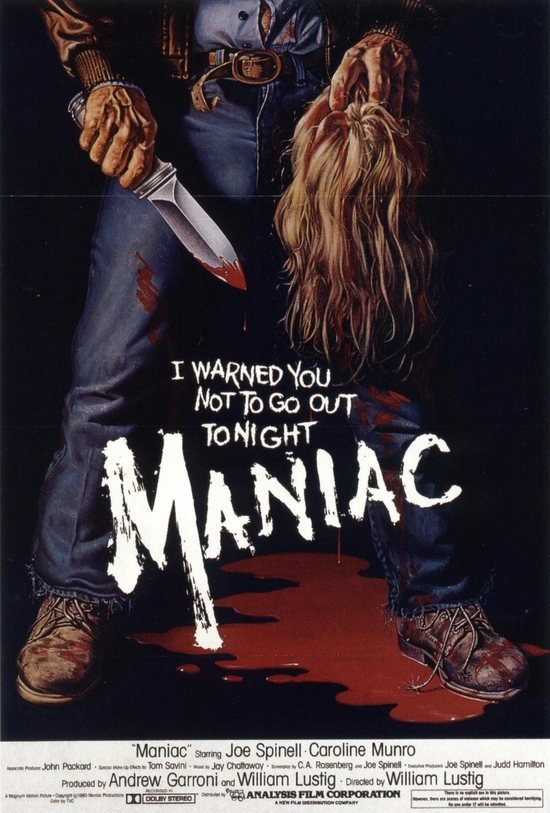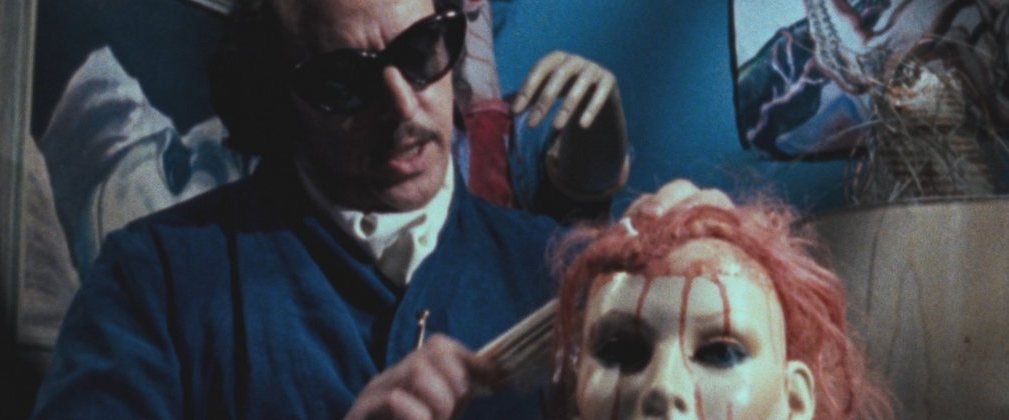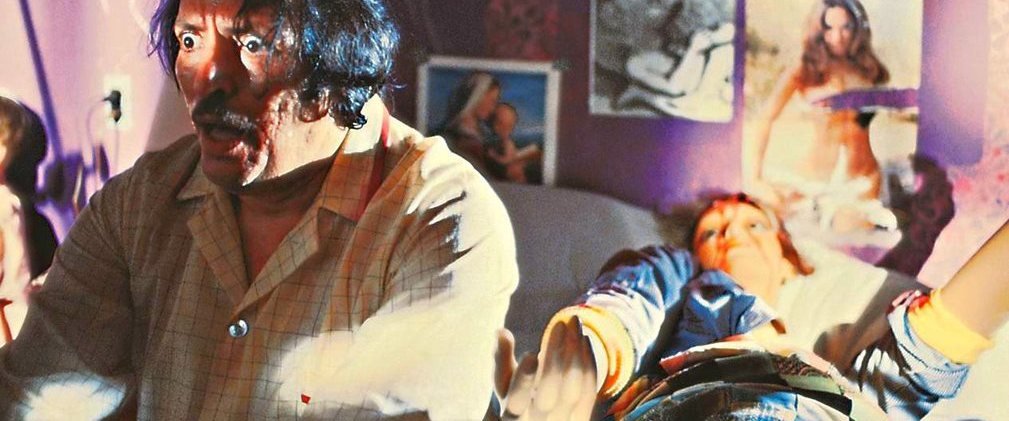MANIAC (1980): A Serial Killer Prototype Infiltrates The Slash-Pack
Maniac spent many years being considered the odd man out of the slasher genre, the kind of film that even made gorehounds squirm with discomfort. The reason for this is that Maniac really isn't a slasher movie at all. Instead, it's an early example of the serial killer character study that would come into vogue a few years later with films like Henry: Portrait Of A Serial Killer. Adding further complexity is the periodic use of gothic horror styling and the kind of splatter effects associated with more rollercoaster-style horror fare. The result was very much ahead of its time and there's plenty to unpack here, including some aspects it often does not get credit for. Maniac revolves around the sweaty, demented persona of Frank Zito (Joe Spinell), a loner who lives in a ramshackle apartment filled with female mannequins. He spends much of his time dressing them and talking to them. When he ventures out, his usual order of business is murdering and scalping lovely young women. His ramblings between killings often reference his deceased mother, whose abuse played a role in putting him on his current path. A chance encounter with Anna (Caroline Munro), a fashion photographer, causes him to attempt a step into the normal world with fateful consequences for all involved.The resulting film is a skin-crawling experience. This isn't because of the scares, though the film does feature a number on well-calibrated setpieces. It's because both the filmmaking and the script force us into lockstep with Zito: the audience can see the horror and tragedy of his actions in plain sight but they are forced to witness them from his vantage point, with Zito's stream-of-psychotic-consciousness ramblings filling their ears from start to finish.Even the oft-criticized subplot with Anna works if you think of it along these terms: those scenes feel so weird and implausible because we're getting them through the damaged, skewed perception of Frank Zito. In fact, one could go even further and argue that the entire film is a fever dream going on in his hothouse of a mind because the film opens and closes with scenes that involve waking up from scenes of carnage in a way that suggest the lines of dream/reality have been hopelessly blurred.
Maniac revolves around the sweaty, demented persona of Frank Zito (Joe Spinell), a loner who lives in a ramshackle apartment filled with female mannequins. He spends much of his time dressing them and talking to them. When he ventures out, his usual order of business is murdering and scalping lovely young women. His ramblings between killings often reference his deceased mother, whose abuse played a role in putting him on his current path. A chance encounter with Anna (Caroline Munro), a fashion photographer, causes him to attempt a step into the normal world with fateful consequences for all involved.The resulting film is a skin-crawling experience. This isn't because of the scares, though the film does feature a number on well-calibrated setpieces. It's because both the filmmaking and the script force us into lockstep with Zito: the audience can see the horror and tragedy of his actions in plain sight but they are forced to witness them from his vantage point, with Zito's stream-of-psychotic-consciousness ramblings filling their ears from start to finish.Even the oft-criticized subplot with Anna works if you think of it along these terms: those scenes feel so weird and implausible because we're getting them through the damaged, skewed perception of Frank Zito. In fact, one could go even further and argue that the entire film is a fever dream going on in his hothouse of a mind because the film opens and closes with scenes that involve waking up from scenes of carnage in a way that suggest the lines of dream/reality have been hopelessly blurred. This is a challenging approach but it works for a few reasons. The first is an astonishing performance from Spinell. He'd been stealing scenes in movies for years like The Godfather Part II, Rocky and Taxi Driver but he gets a true opus for his skills here. The film is designed in a way that he has to carry the entire dramatic portion on his shoulders and he makes it look effortless as he rages, weeps, does character voices and makes a meal out of countless tormented monologues. The resulting performance is creepy and compelling in equal measure, the kind of thing you never forget.The other reason that Maniac works is the direction of William Lustig. It's the work of someone who is acquainted with the conventions of the horror film and knows how to exploit them to his benefit: highlights include a nerve-jangling scene where Zito stalks a nurse through an abandoned subway station at night and a disturbing moment that seems to reference the Son Of Sam murders when a shotgun-toting Zito corners a pair of lovebirds in a car.In such scenes, he makes great use Robert Lindsey's photography, which blends gritty visual textures with sleek camera movement, and a synth score from Jay Chattaway that alternates between pulse-pounding riffs and somber dreamscapes. Of course, the jaw-dropping makeup FX of Tom Savini are just as important to these scenes: he delivers the kind of Grand Guignol effects that made him famous during this era, including a (literally) mindblowing scene that also involves him as an actor.
This is a challenging approach but it works for a few reasons. The first is an astonishing performance from Spinell. He'd been stealing scenes in movies for years like The Godfather Part II, Rocky and Taxi Driver but he gets a true opus for his skills here. The film is designed in a way that he has to carry the entire dramatic portion on his shoulders and he makes it look effortless as he rages, weeps, does character voices and makes a meal out of countless tormented monologues. The resulting performance is creepy and compelling in equal measure, the kind of thing you never forget.The other reason that Maniac works is the direction of William Lustig. It's the work of someone who is acquainted with the conventions of the horror film and knows how to exploit them to his benefit: highlights include a nerve-jangling scene where Zito stalks a nurse through an abandoned subway station at night and a disturbing moment that seems to reference the Son Of Sam murders when a shotgun-toting Zito corners a pair of lovebirds in a car.In such scenes, he makes great use Robert Lindsey's photography, which blends gritty visual textures with sleek camera movement, and a synth score from Jay Chattaway that alternates between pulse-pounding riffs and somber dreamscapes. Of course, the jaw-dropping makeup FX of Tom Savini are just as important to these scenes: he delivers the kind of Grand Guignol effects that made him famous during this era, including a (literally) mindblowing scene that also involves him as an actor. But Lustig's direction is also interested in more than staging shocks. The scenes with Zito delivering soliloquies to the mannequins in his apartment play like theater of the absurd. He also finds ways to visually express a kind of pathos for his monstrous anti-hero, the best being a moment where he stares longingly at mannequins in a shop window while a broken lullaby plays on the soundtrack. Finally, it's worth noting that Lustig does a great job of capturing the seedy vibe of New York in the dangerous days before Times Square was cleaned up. Anyone interested in the wild west days of the Deuce will be fascinated by the sordid atmosphere this film effortlessly conveys.Simply put, Maniac is not a slasher film nor is it just a quirky oddity from the early days of the splatter movie boom. It is a grimly artful piece of work that deserves a place in the pantheon of dark modern horror. Once you make your way through its sleazily nightmarish labyrinth, you'll find it's taken root in your celluloid memories.Blu-Ray Notes: Blue Underground recently released a 3-disc set (2 blu-rays, 1 CD) that is the definitive release of this set. You get a fantastic new transfer from the original 16mm negative, all of the old extras, a fistful of new special features and a full compact disc of the Jay Chattaway score. Simply put, this is the release of this film to own.
But Lustig's direction is also interested in more than staging shocks. The scenes with Zito delivering soliloquies to the mannequins in his apartment play like theater of the absurd. He also finds ways to visually express a kind of pathos for his monstrous anti-hero, the best being a moment where he stares longingly at mannequins in a shop window while a broken lullaby plays on the soundtrack. Finally, it's worth noting that Lustig does a great job of capturing the seedy vibe of New York in the dangerous days before Times Square was cleaned up. Anyone interested in the wild west days of the Deuce will be fascinated by the sordid atmosphere this film effortlessly conveys.Simply put, Maniac is not a slasher film nor is it just a quirky oddity from the early days of the splatter movie boom. It is a grimly artful piece of work that deserves a place in the pantheon of dark modern horror. Once you make your way through its sleazily nightmarish labyrinth, you'll find it's taken root in your celluloid memories.Blu-Ray Notes: Blue Underground recently released a 3-disc set (2 blu-rays, 1 CD) that is the definitive release of this set. You get a fantastic new transfer from the original 16mm negative, all of the old extras, a fistful of new special features and a full compact disc of the Jay Chattaway score. Simply put, this is the release of this film to own.


